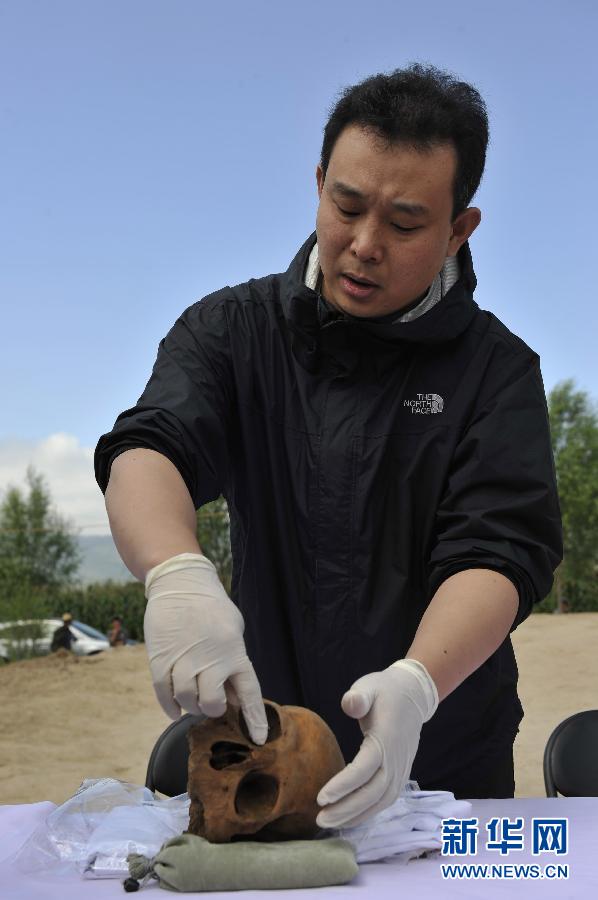From: Beachcombing'sBizarre History Blog September 5, 2014
Author: Beach Combing | in : Medieval , trackback
Here is a story that has come out of the Chinese media in the last few days and that has been little noticed in the west, certainly it has been little discussed. The reports are unsatisfactory in all kinds of ways. But the bare bones of information includes the following: in M1401, an early medieval (in European terms) tomb in Guyuan City in North-Western China, part of a skull has been discovered. This skull has been judged to be ‘western’.
This begs all kinds of questions. First in what way is the skull associated with the tomb: was it one of several or was it the remains of the principal tenant? Second, how do we know the skull is western? One professor involved in the dig has gone on the record as saying: ‘The man had a protruding nasal bone and a sunk nasion, which are typical features of Europeans’. Beach is not a biologist, an archaeologist or a sinologist, but the first part of the sentence sounds dangerously like Europeans have big noses, therefore… See the picture. Third, what is meant by ‘European’ given that, from the Tarim Mummies onwards, many Caucasian individuals are to be found in western China and many Caucasians hold Chinese passports today? Can anyone help with these points? Drbeachcombing AT yahoo DOT com
But leaving aside these doubts and questions – and Chinese archaeology has professionalized dramatically in the last generation – how strange would it be to find a European in Guyan in the seventh, eighth or ninth century? Well, Guyan was on the Silk Road and silk continued to run through to the Mediterranean in this period, even as the Persians and Byzantines were learning how to make it themselves. Then there is also the implication that silk may have come directly up the great rivers that make the borders of Europe, particularly the Volga, into the Baltic: there is good evidence for a Viking taste for silk. We know too little about the intermediaries between these two worlds: we cannot trace how these goods passed backwards and forwards, a process that is shadowy in the much better documented Roman period. But there were clearly caravans and it is likely that some people of Caucasian type passed backwards and forwards along these routes: again this is not as dramatic as it may seem given that ‘Caucasian’ types are found deep into Asia. There is so much that is exciting in those fleeting contacts between east and west, but Beach would not like to build even a mud hut’s foundations on the big-nosed skull from M1401, at least not without more information.
24 Sept 2014: ANL writes: You point out that “there is also the implication that silk may have come directly up the great rivers that make the borders of Europe, particularly the Volga, into the Baltic: there is good evidence for a Viking taste for silk.” Silk has been found in quite a few tombs of the Hallstatt culture (8th to 6th century BC), so this is nothing new, and it probably followed the same route up the Danube.
European man's remains found in ancient Chinese tomb
YINCHUAN, Aug. 17 (Xinhua) -- The remains of a human skull found in a 1,400-year-old tomb in China possibly belonged to a man of European origin, an initial investigation by scientists revealed on Sunday.
The skull was found in the M1401 tomb in Guyuan City in northwest China's Ningxia Hui Autonomous Region.
"The man had a protruding nasal bone and a sunk nasion, which are typical features of Europeans," said Zhang Quanchao, professor with the Research Center for Chinese Frontier Archaeology of Jilin University.
Zhang believes the skull belonged to a 40-year-old man of European origin.
Further excavation is needed for a firm conclusion, he said.
"If we can find his teeth and more bones, we will have a more precise judgement about his age," he said.
The tomb was first discovered in the 1980s. Illegal excavation was reported this year, and archaeologists began to unearth the tomb in June for protection.
More than 40 clay figures, copper coins and a number of murals were found in the tomb, according to Zhu Cunshi, head of the archaeological team.
Zhu said the tomb was built in the early Tang Dynasty (618-907).
Ningxia is along the ancient Silk Road that connected China with Europe through commerce.

1 comment:
Fantastic, thanks for the comment Ursula!
Post a Comment